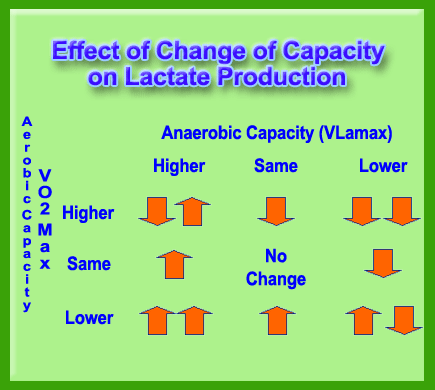Quote:
Does the "training to train" system explain and/or quantify the semi-apocryphal gains that Mark Allen achieved under the Maffetone running system and the early-season "patience" phase?
I am not knowledgeable on what Mark Allen did or the Maffetone running system so I cannot answer that. When I wrote this I was quoting a top coach in the US. He mainly trained runners but also advised some swimming coaches. After working with Olbrecht for several years I believe the best way to interpret this is that aerobic capacity slowly increases over years and certainly increases during a season. So a lot of the training is building this aerobic capacity so that one can then train harder later on. These harder workouts will not be at a higher percentage of VO2 max and therefore no more stressful. But one has to be careful that aerobic capacity has truly increased. For a discussion of aerobic capacity or VO2 max see this on our site.
http://www.lactate.com/vo2max.html For example, Olbrecht once told me that a 50 m swimmer uses almost none of his or her aerobic system for energy during a race. But that a strong aerobic base is necessary for tolerating the training at higher levels even for pure sprinters. Someone like Pieter van den Hoogenband who held the 100 m freestyle record for nearly 8 years had a very high aerobic capacity which allowed him to workout at much higher levels even though most of the energy for his race would be provided by anaerobic systems. And one of the swimmers he advised for the London Olympics (Ranomi Kromowidjojo) set the Olympic records in the 50 and 100 m freestyle. She has and needs an extremely high aerobic capacity to tolerate the hard training regimen and also to recover faster.
For endurance athletes such as triathletes the aerobic system is the main source of energy but it has to be slowly built so that even harder workouts can be tolerated later on. One of the problems with endurance athletes is that they can get faster by lowering their anaerobic capacity and this lulls the athlete into thinking he or she is now more fit and will then train harder. This often has negative results.
I am sure there will be many who will disagree but it is food for thought. That is why it is important to know if any improvements are from an increase in aerobic capacity or due to a decrease in anaerobic capacity.
Quote:
the object of my training should be to increase my LT as a %age of VO2 max? And that the main physiological way to do that is by increasing mitochondrial mass in muscle cells?
Increasing the LT is highly desirable but one has to understand just how it is being done. Some ways have long term benefits while others are only of temporal value.
Here is a chart with some accompanying text from our website on the triathlon
http://www.lactate.com/...bic_controlling.html Implications for Training Since training can affect both of these capacities in ways not always expected, it is useful to continually monitor an athlete to assess whether training is having the desired effects. The following chart indicates what can happen to lactate levels when aerobic and anaerobic capacity changes.

The chart can be read as follows. In the upper left hand box where anaerobic capacity rises and aerobic capacity also rises, lactate production could go up or down at a specific effort level. An increase in anaerobic capacity will tend to increase lactate production while and an increase in aerobic capacity will tend to lower it. So when both of these capacities increase, the net effect could be either higher or lower lactate production. It could go up or down depending upon which change had a greater effect.
When aerobic capacity goes up and anaerobic capacity goes down, the amount of lactate produced is often dramatically less. This is a situation quite common with swimmers and many other athletes during base training. However, when a swimmer increases anaerobic capacity training later in the training cycle it is quite common to see lactate levels rise because aerobic capacity has essentially topped out for the training period. Thus, the athlete is in the middle box on the left hand side. For an athlete such as a swimmer who is competing in short events (1-2 minutes) this is an indication that they are getting faster as their anaerobic system will be producing energy more quickly during these short events.
For triathletes they should know which box they fit in or else they can not accurately assess their training.
---
This is getting long so I will stop here. As far as the Olbrecht book helping triathlon training, all the principles are applicable to any form of training though the book is focused on competitive swimming which are mainly anaerobic events. One of the athletes he advised won the 10 k swimming event in Beijing. He also used them with Luc van Lierde and other triathletes.
--------
Jerry Cosgrove
Sports Resource Group
http://www.lactate.com https://twitter.com/@LactatedotCom
